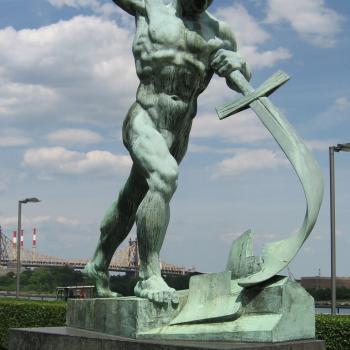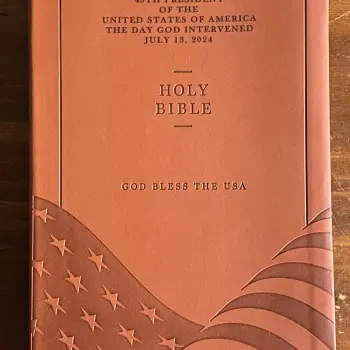Gas and oil reserves discovered in the Levant/Levantine Basin of the Eastern Mediterranean Sea could prove to be a huge game-changer for Palestinians if they were to adopt my proposal for the location of their desired state. The wealth they could realize, and the economic security of becoming energy independent and perhaps an energy exporter, could cause nearly all Palestinians in the West Bank to decide they would prefer relocating to this territory and letting Israel have all of the West Bank.
For forty-five years, the Palestinians, as well as much of the world, have focused on a Palestinian state being located in the two separated territories of the Gaza Strip and the West Bank (now a Swiss-cheese West Bank), with East Jerusalem as its capital. This focus is based on present demographics, which does not necessarily prove best. In my book, Palestine Is Coming: The Revival of Ancient Philistia (1990), I argue that this geographical arrangement would be militarily indefensible and economically unsustainable for the Palestinians. Thus, I conclude that if it happens it likely will not succeed. Plus, it does not meet the widely-accepted language of “two states lying side-by-side” which U.S. President George W. Bush invoked in a speech delivered in 2002, when he became the first U.S. President to endorse the two-state solution to the Israeli-Palestinian conflict. But my proposal does.
I propose that a Palestinian state be established according to historical precedent as follows: (1) let Israel have all of its ancestral land, as it claimed in its 1948 Proclamation of Independence, but was never achieved, and (2) let Palestinians have “the land of the Philistines.” The Philistines, from whom Palestinians derive their name, were the archrival of the ancient Israelites. I suggest that “the land of the Philistines” be defined by much of historical precedent, so that its borders would be as follows: (1) the northern border is the Nahal Sorek, eight miles south of Tel Aviv, (2) the eastern border is the Shephelah and western environs of Beersheba and Kadesh Barnea, (3) the southern border is the Wadi El Arish Basin, and (4) the western border is the Mediterranean Sea. I call this “the New Philistia Proposal.” In it, Israel would forfeit its coastal plain south of the Nahal Sorek, which includes the cities of Ashkelon and Ashdod. Philistia was a pentapolis consisting of five city-states: Gaza, Askelon, Ashdod, Ekron, and Gath.
Moreover, I claim in my book that at least ten prophecies in the Jewish Bible (Old Testament) indicate that such a Palestinian state, or something geographically resembling it, will be the future outcome of the present, ongoing Israeli-Palestinian conflict.
It has been over forty-five years since the 1967 Six-Day War, when Israel defeated neighboring Arab nations and took “the occupied territories.” Israel returned the Sinai Peninsula to Egypt and the Gaza Strip to the Palestinians. But it has never returned the Golan Heights to Syria or the West Bank and East Jerusalem to the Palestinians. And the Palestinians never got their desired state. I think it’s time they consider other alternatives, especially due to recent offshore carbon discoveries. What are they?
In 1999, the Palestinian Authority signed a 25-year agreement with the British Gas Group and its partner to explore for oil and gas in Mediterranean waters offshore from the Gaza Strip. (It wasn’t such a good deal for the Palestinians since it only allots them 10% of the profits.) In 2000, British Gas drilled two wells about 20 miles offshore, 2,000 feet under the seabed, and discovered natural gas. These two wells were named Gaza Marine-1 and Gaza Marine-2. Israel then announced that all gas and oil found offshore from the Gaza Strip would be owned by Israel until a peace agreement is achieved between Israel and the Palestinians. Consequently, there still has been no development of these two wells.
In 2004, Israel discovered the Meged oil field straddling the western border of the West Bank. Even if this entire reservoir lies within the West Bank, so that all of it is regarded as belonging to the Palestinians, this discovery pales economically in comparison to what Palestinians could realize from oil and gas deposits in the Eastern Mediterranean Sea with a much longer coast than the Gaza Strip.
Noble Energy, Inc., is an independent oil and gas drilling contractor headquartered in metro Houston, Texas, my home for nearly forty years. As an S&P 500 company, Noble Energy is one of the world’s largest offshore drilling companies, with ninety-two years in business. Thanks to recent advances in offshore drilling technology, they have much experience drilling very deep-water wells in the Gulf of Mexico. As of April, 2013, Noble Energy was operating seventy-nine offshore drilling units around the world, and five of them are ultra-deepwater rigs. So far, Noble has dominated the drilling Israel’s offshore oil and gas resources.
In 1998, a consortium of four oil and gas contractors led by Noble Energy entered into contract with the State of Israel. They began drilling operations that year offshore from Israel in the Levant Basin of the Eastern Mediterranean Sea. The next year, in 1999, Noble discovered a large gas reservoir twenty miles offshore from the coastal city of Ashkelon, which they named the Noa field. In 2000, Noble discovered the Mari-B reservoir ten miles from the coast, and then the Pinnacles gas field next to it, all of which was named the Yam Tethys (Tethys Sea) gas fields for the name of the partnership that discovered them. Israel then built an oil and gas processing terminal at Ashkelon. And Israel had an underwater gas pipeline laid from these gas fields which connected to the processing facility at Ashkelon. Noble has been producing gas from the Mari-B field for Israel since 2004 which connects to the Ashdod Onshore Terminal. As of 2013, they had depleted the deposits and were considering using its reservoir to store natural gas from other fields.
In September, 2013, Jewish-owned Shemen Oil and Gas Resources became the first oil and gas drilling coming to discover oil off Israel’s coastline. It discovered oil reserves estimated to be worth $11 B at today’s crude oil prices ($100 per barrel) at its Yam 3 well located fifteen miles offshore from Ashdod. Although not large, it is a very significant discovery because it is oil and of a high quality. Natural gas reserves are very lucrative; but oil reserves are much more so. Oftentimes, natural gas deposits lie just above oil deposits. So, while most Levant Basin energy discoveries so far have been almost all natural gas, it is expected that drilling farther down will result in the discovery of significant oil reserves as well.
Noble later began drilling operations farther north and further out to sea. In 2009—at fifty miles offshore from the coastal city of Haifa in 5,500 feet of water and at 13,000 feet under the Mediterranean seabed—Noble found a natural gas reserve that Israel named Tamar. (Haifa is Israel’s second largest city and its largest industrial sector. In April, 2013, Noble brought this Tamar field online, thus connecting it to the Ashdod Onshore Terminal.) In 2010—at thirty miles farther out to sea and at 17,000 feet under the seabed—Noble discovered another, much larger, natural gas reserve which Israel named Leviathan. These two natural gas reserves alone, Tamar and Leviathan, are estimated to meet Israel’s gas energy needs for the next 50, if not 100, years. Israel is even considering becoming an exporter of liquefied natural gas (LNG) to especially the European Union (EU). Israel is also considering building an offshore, floating LNG processing facility in this exploratory region. Noble expects in the future to discover other Eastern Mediterranean natural gas reserves in Israeli seawaters.
Noble also contracted with the island Republic of Cyprus. In 2011, Noble discovered its fifth Eastern Mediterranean gas reserve, and another in 2012, both in the territorial waters of Cyprus. In mid-2013, Noble and partners signed a memorandum of understanding with Cyprus to build an LNG plant on its southern coast, and some of this LNG will be exported to the EU. In late 2012, Lebanon issued its first oil and gas licensing round for its Mediterranean territorial waters. Syria has not done so due to its ongoing civil war. So far, the Levant Basin has been explored very little, so it is a new frontier in oil and gas drilling. Noble expects that it holds substantial quantities of oil as well.
Such discoveries are proving significant for especially Israel, Lebanon, Syria, and Cyprus, if not Turkey and Egypt. Surveys of carbon deposits have been conducted in Lebanon’s territorial waters, and they indicate Lebanon will benefit immensely as well.
In fact, in 2010 the U.S. Geological Survey estimated that the entire Levant Basin contains 8.5% of the world’s known natural gas reserves, which is a huge amount. It also estimated that that the basin contains 1.7 billion barrels of recoverable oil.
Israel and Lebanon presently dispute the maritime boundary between them. Politically, they have remained in a state of war since 1967. Seyyed Hassan Nasrallah, Secretary General of Hezbollah, warns that Hezbollah will attack Israel if it exploits offshore energy deposits belonging to Lebanon.
In 2010, Lebanon made a formal presentation to the UN, arguing that much of the Leviathan reserve lies within Lebanon’s territorial waters. Israel then submitted its contrary argument to the UN, claiming its northern maritime boundary should extend farther northward, in which all of the Leviathan gas reserve would belong to Israel. This disagreement results in a 330 square-mile overlap. The U.S. also has attempted to mediate this dispute.
Arguments about maritime boundaries between nations have not been that important in the past except to decide fishing and navigation rights. They become much more important when large oil and gas deposits are discovered offshore within these disputed boundaries. But oil and gas drilling companies consider the political stability of a region in deciding where to drill. Yet, some authorities say the economic prospects of it could help bring peace between Eastern Mediterranean nations.
Due to these and other anticipated future discoveries of gas and oil, maritime boundaries no doubt will be disputed between other Eastern Mediterranean countries. In the past, a maritime border dispute between two nations has only been resolved by negotiation between them. The UN Convention on Law of the Sea provides that territorial waters of maritime nations extend 200 nautical miles from their shore out to sea. The region inside these borders is called the “exclusive economic zone” (EEZ). But the Eastern Mediterranean Sea is smaller than vast oceans, with Cyprus inside it.
Regarding the Palestinians, the question remains whether the Mari-B, Noa, and Pinnacles gas reserves belong to Israel or the Palestinians. And there likely will be other such discoveries in these waters in the future which will bring this question more to the forefront. Gas and oil reserves that conceivably lie offshore from much of the Eastern Mediterranean coast could bring considerable wealth to Palestinians if they were to adopt my New Philistia Proposal and it became a reality.
To do so, I suggest Palestinians do the following: (1) declare that their ancestors are mostly the ancient Philistines by asserting that they have a stronger genetic link to them than to any other ancient, ethnic group, and (2) thereby claim “the land of the Philistines” as their ancestral land whereupon to establish their State of Palestine. It would be much like the Jews did in 1948 with their Proclamation of Independence, in which they claimed a right to their “ancestral land.” Palestinians then would claim an EEZ, a maritime boundary that would include Gaza Marine 1 and 2, Mari-B, Noa, Pinnacle gas reserves, and any other oil and gas reserves to be discovered therein in the future. Of course, an important factor would be determining the location of the maritime boundaries of this future State of Palestine in relation to those of its only two neighbors: Israel and Egypt.
The Mediterranean coastland for this proposed Palestinian state would be about eighty miles in length, and Israel’s total coastland would be reduced to eighty miles in length as well. Israel’s coastland would be a fairly straight line except for the slight indentation at Haifa. But the coastland for this proposed Palestinian state bends inward to form a slight U-shape. If both the maritime boundaries north and south for this Palestinian state were extended perpendicularly from the shore out into the Mediterranean Sea, that would leave the Palestinians with a much smaller territorial sea area in which to claim mineral rights than the area for Israel if its north-south maritime boundaries also extended perpendicularly out into the sea. This result is unfair for the Palestinians.
It would seem that a more equitable determination of the maritime boundary lines for this proposed Palestinian state and the transformed Israel would be to decide on a fixed point out in the sea to which the northern and southern maritime boundaries of Palestine and perhaps both of Israel’s would meet. Also, the maritime boundary lines for the island of Cyprus would have to be considered in making such a determination. Regarding Lebanon’s maritime boundary which it presented to the UN, it ends eighty-two miles out to sea, which is the halfway point between Lebanon and Cyprus. This determination seems fair.
The Palestinians have constantly depended for their survival on financial aid from donor nations. These have included Arab some states, the U.S., and EU. With the New Philistia Proposal, and the economically lucrative gas fields and perhaps oil fields offshore of its eighty-mile coastland, it would seem that the Palestinians would not have to depend on donor nations anymore. Also, some of the wealth to be realized from these offshore carbon deposits by both Israel and Palestine could finance the necessary transfer of peoples from the two regions to make this proposal possible. (See “Transfer of Peoples” article at kermitzarley.com.)
Victor Kattan, program director of Al-Shabak: The Palestinian Policy Network, says of the Gaza natural gas fields alone, “If the gas off the shore of Gaza were sold at market price, the PA [Palestinian Authority] would earn huge windfalls in revenue,… the Palestinian economy could save more than $8 billion in energy costs over the life of the project, if the gas were used for generating electricity in Gaza and in the West Bank. In other words, an independent Palestinian state would not, in the future, have to survive on aid from the international community, but would have sufficient resources to be able to finance its own development.”[1] It would be much more so for the New Philistia Proposal with its EEZ due to an eighty-mile coastland.
Another consideration that has held up development of these offshore Gaza gas fields has been Hamas, the political party that governs the Gaza Strip. Hamas has threatened that if it is not included in an agreement to receive financial benefit from such development, it will sabotage such operations with attacks. Indeed, oil and gas operations and their pipelines are easy targets for saboteurs. This is another reason why these Gaza natural gas fields likely won’t be developed until there is a State of Palestine.
If a Palestinian state were to become established according to this New Philistia Proposal, and it received Nile River water through the Al-Salam Canal, it could perhaps barter with Egypt, that is, trade some of its oil and gas for some of Egypt’s Nile water. (See “Al-Salam Canal” article).












